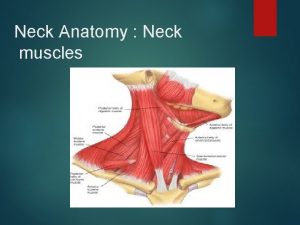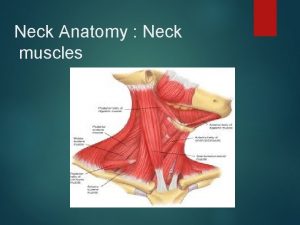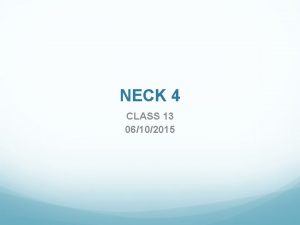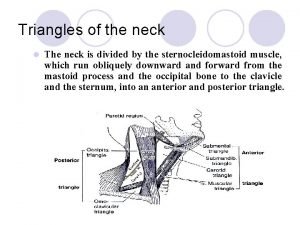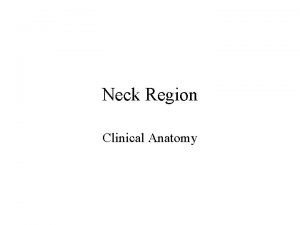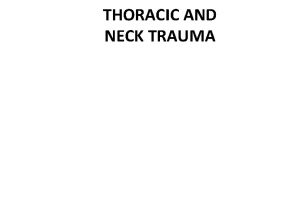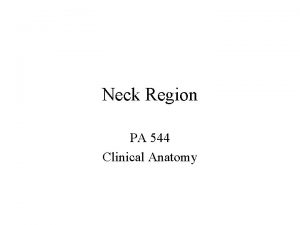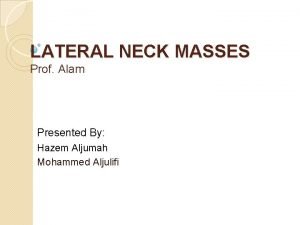NECK MASSES Neck masses Introduction Common in children
























- Slides: 24

NECK MASSES

Neck masses - Introduction Ø Common in children Lymphadenopathy – response to infection Ø Less common in adults Malignant until proven otherwise

Neck masses - Children Ø Larger lymphoid mass Ø Brisk lymphoreticular response Ø Present with lymphadenopathy after minor infections Ø Nodes may continue to enlarge after initiation of treatment and resolution of infection

Neck masses - Children Ø Causes - benign 80% - bacterial - viral - TB - HIV (Drainage from throat, nose, ear, scalp) - malignant 20% - lymphoma

Neck masses - Causes Ø Congenital (present at birth) Ø Developmental Ø Neck space infections Ø Salivary glands Ø Thyroid

Causes - Congenital Ø Lymphangiomata : Simple and cavernous Cystic hygroma Ø Dermoids : Epidermoid True dermoid Teratoid Ø Thyroglossal cysts : along tract of thyroglossal duct 90% midline may be only functioning thyroid tissue

Causes - Developmental Ø Branchial cysts - various theories - can become infected - treat with aspiration and antibiotics - excision when infection settled

Causes – Neck space infections Ø Parapharyngeal abscesses : - tonsillitis, quinsy, lower 3 rd molar abscess - swelling posterior to sternomastoid - stridor Ø Prevertebral / retropharyngeal abscess - acute suppurative otitis media

Causes – Salivary gland, Thyroid Ø Salivary gland : - mumps - recurrent parotitis of childhood - HIV Ø Thyroid - pubertal goitre :

Management Ø Clinical history and examination Ø Masses requiring investigation : - clinically suspicious - not responding after appropriate treatment (4 – 6 weeks) Ø Fine Needle Aspiration

Neck masses - Adults Ø Always presents as a pathological condition Ø History and clinical evaluation will lead to disease diagnosis in most cases Ø Neck masses usually related to diseases of the lymph nodes (80 % malignant) Ø Incidence of neoplasia increases with age

Metastatic neck node – N 3

Neck masses - Epidemiology Ø Heavy smoking and alcohol abuse Ø Adult male population ( > 40 years ) Ø Painless, slow growing mass ( level II/III ) Ø Radiation exposure in the past Ø Curative treatment in the distant past for other malignancy

Neck masses – History taking Ø Otalgia Ø Blocked nose Ø Epistaxis Ø Unilateral hearing loss Ø Dysphagia / Odynophagia Ø ( Hoarseness / Dysphonia, Stridor )

Lymph drainage - Neck

Neck mass - Levels Ø Levels I to VI, Robbins (1991) • • • Level I – submental and submandibular Level II – upper jugular Level III – middle jugular Level IV– lower jugular Level V – posterior triangle Level VI– anterior compartment

Levels of the neck

Neck masses - Causes Ø 80 % of neck masses in adults (>40) are malignant Ø Of those, 80% will be squamous cell carcinoma Ø Of those, in 80% the primary will be found Ø Of those, 80% will be in the head and neck region

Neck mass – work-up Ø Careful head and neck examination Ø In majority of cases a primary will be found Ø Examination should include the following areas : oral cavity, nasopharynx, oropharynx, larynx, hypopharynx Ø Examination under anaesthetic Ø Examine skin, thyroid, salivary glands

THE MOST ACCEPTABLE TEST TO ESTABLISH THE DIAGNOSIS IS FINE NEEDLE ASPIRATION CYTOLOGY

Neck masses - Cytology 1. Squamous cell carcinoma undifferentiated carcinoma : ENT examination EUA CT scan MRI

Neck masses - Cytology 1. Adenocarcinoma : ENT examination EUA CT scan, MRI (including abdomen) thyroid / kidneys /adrenals lungs examination of breast, prostate, endometrium

Neck mass – Cytology (cont) 1. Non-Hodgkin’s lymphoma : ENT examination, EUA with guided biopsies, CT scan thorax and abdomen, bone marrow biopsy, excision of single node for histological examination 1. Melanoma : ENT examination, dermatological and ophthalmological examination, CT/ MRI head and neck

Neck masses - Summary Ø Commonest cause in children is infective Ø Give 4 – 6 weeks to resolve Ø Commonest cause in adults is malignant Ø FNA Cytology the only diagnostic tool
 Exceptional children 11th edition
Exceptional children 11th edition Exceptional children an introduction to special education
Exceptional children an introduction to special education Common factors of 18 and 27
Common factors of 18 and 27 Common anode and common cathode
Common anode and common cathode Lcm questions
Lcm questions Highest common factors and lowest common multiples
Highest common factors and lowest common multiples Lcm of 12 and 18
Lcm of 12 and 18 Highest common factors and lowest common multiples
Highest common factors and lowest common multiples Common lisp a gentle introduction to symbolic computation
Common lisp a gentle introduction to symbolic computation Why are cold fronts steeper than warm fronts
Why are cold fronts steeper than warm fronts Jet stream map
Jet stream map Occluded front gif
Occluded front gif Large rotating air mass
Large rotating air mass Two astronauts of masses 60 kg and 80 kg
Two astronauts of masses 60 kg and 80 kg Les masses en maternelle
Les masses en maternelle Balancing of several masses rotating in the same plane
Balancing of several masses rotating in the same plane Units of charge
Units of charge Periodic table with molar mass
Periodic table with molar mass Importance of air masses
Importance of air masses Characteristics of air masses
Characteristics of air masses Astronomers measure the masses of stars by
Astronomers measure the masses of stars by Types of air masses in north america
Types of air masses in north america Continental polar symbol
Continental polar symbol Air fronts
Air fronts Air mass notes
Air mass notes

























